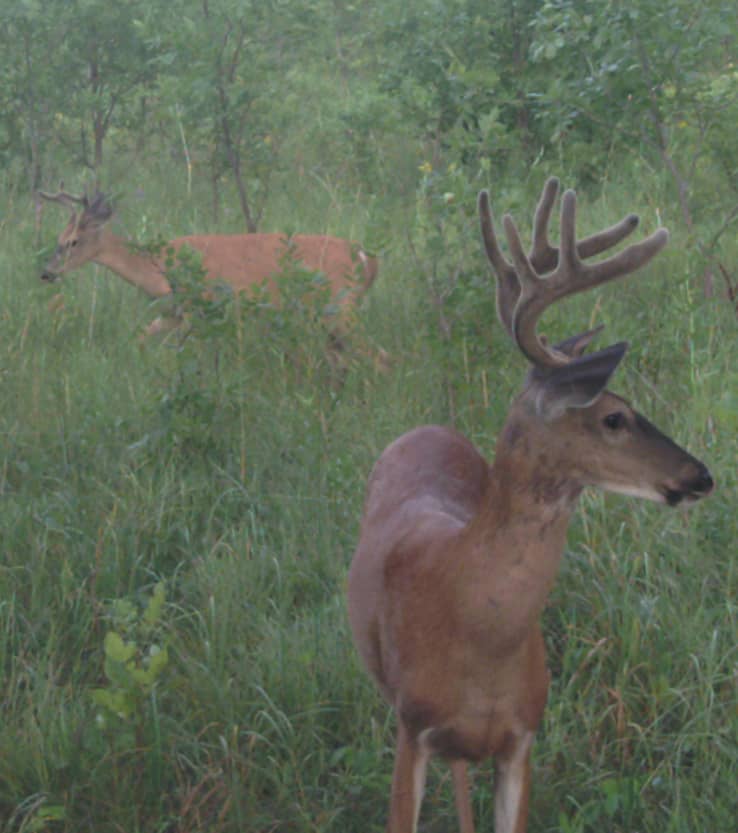
Before you take a shot at that first buck of the season, be sure to have your safety system in place when stand hunting. Simonson Photo.
By Nick Simonson
There’s a truck stop just down the road from where I often find myself suspended in my tree stand each fall, and one night after a hunt, I stopped in to grab a pop and a late dinner for the drive back into town.
A trucker with a well-worn Alabama Crimson Tide baseball cap looked up at me in my full camouflage and safety harness as I walked in and asked me in a deep southern drawl how hunting had gone, before remarking: “you’re the first hunter I’ve ever seen wearing one of those” as he pointed to my lanyard hanging down over my shoulder. We traded a couple of quick hunting stories as we stood at the register and he wished me good luck, and I wished him safe travels. On my way back home, I thought of his comment on the lanyard-and-harness combo still wrapped around my torso.
I’ve never been a fan of heights, and even after a decade of deer hunting from an elevated perch, the first couple of sits each season require a little getting used to, even though many of my stands aren’t that high up when compared to those of my contemporaries. But no matter how tall a stand is, each one of them has a big black strap above the seat where the 500-pound rated carabiner and my harness lock into place. Like a life jacket in the boat or a seatbelt in the truck, the first thing that goes on and the last thing that comes off when I take the stand is my safety harness.
It’s with good reason too. Year after year, thousands of hunting injuries occur throughout North America, and the bulk of them are not firearms-related accidents either, as many unfamiliar with our passions might assume. Rather, it is falls from elevated stands that do the most damage to hunters, resulting in broken bones, damaged spinal columns, paralysis, and even death. Regardless of whether the model is a ladder, hang-on, or climber stand, reports of falls from these tree-based positions or in the process of getting up to them comprise the largest percentage of deer-hunting related injuries and deaths each fall. But with the right safety gear and a bit of precaution, hunters can avoid such trauma and find continued, life-long good hunting from a treestand.
Wear a Harness and Lanyard
Donning a harness and lanyard – which these days come with most every treestand purchased – every time you take the stand, and properly connecting it to a safety strap will help limit falls when seated or standing. Be certain that the lanyard and harness are in good shape and purchase a new one if either has been damaged by a previous fall where it was employed, or if time and exposure to the elements has weakened them. They are easily covered by a light jacket, or camouflage versions or safety vests which incorporate the strapped supports can be purchased for those concerned that they may interfere with their chosen concealment patterns.
Use a Tow Rope
Scaling up a ladder stand or getting into a hang-on stand via screw-in steps or ladder sticks requires both hands and both feet and utilizing a climber stand requires those along with ab muscles, back and shoulders to get into position. In all three scenarios, employ a tow rope for bows and firearms, leaving each weapon on the ground and leaning against the tree, or secured on the rope and hanging below a stationary stand until you’re locked in and secure in the seat. This ensures that all hands are free to grab rungs and arm rests and get you into position and prevents a bow or firearm from falling and getting damaged or worse, causing injury when climbing.
Let Someone Know
Finally, leave a detailed record with family, friends, or a neighbor of where you’ll be when you go out deer hunting, and take a fully charged cell phone with you into the field. Let your contacts know when you’re leaving and when you expect to be back or will be checking in, and what they should do and who they should contact if you don’t connect with them by a certain time. In case of a fall, use your cell phone to call those contacts for help or dial 911 for situations requiring immediate medical attention.
These tips are basic, but they’re also easy to put into action to provide for years of successful stand hunting to come, be it now as bow seasons start up, or when gun seasons roll around in November and it shouldn’t be a surprise when someone spots you in your camo gear and full body harness after a good hunt, which is any one that ends with a safe arrival back home.
